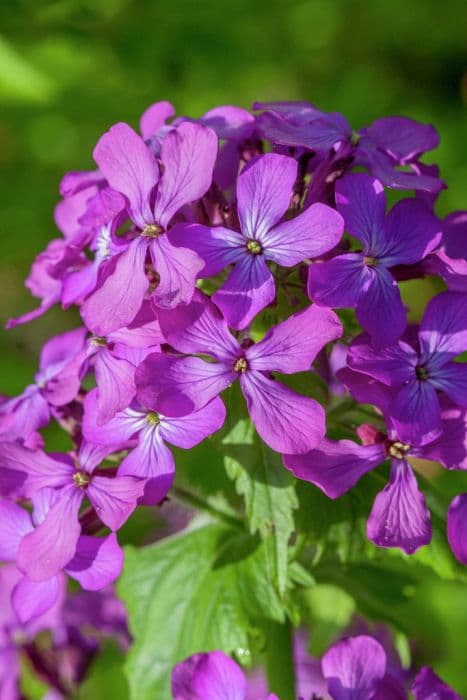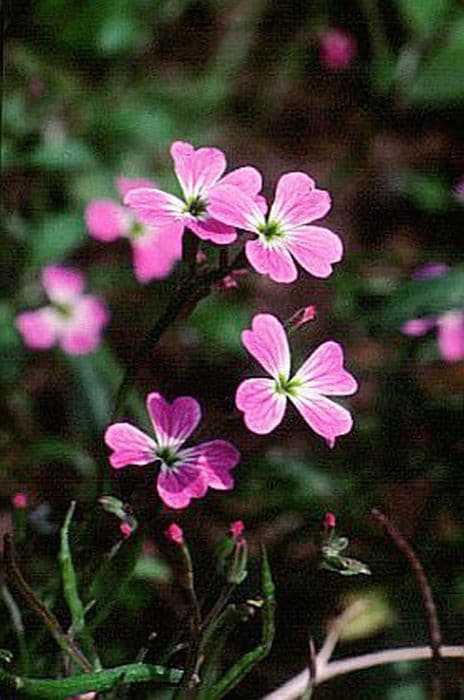Land Cress Barbarea verna

ABOUT
Barbarea verna, commonly known as the land cress or American cress, is a plant with a rosette of dark green leaves at its base. The leaves are typically smooth with a glossy surface and have a jagged or toothed edge, which sometimes resembles the shape of a rounded oak leaf. As the plant matures, the leaves become more deeply lobed and may be held aloft on slender stalks. The land cress produces small, bright yellow flowers that are clustered at the top of vertical flowering stems. These flowers consist of four petals arranged in a cross shape, which is a typical feature of the plants in its family. After the flowering period, the plant forms elongated seed pods known as siliques that contain the seeds for future propagation. Overall, the land cress has a lush and leafy appearance, with foliage that is visually similar to that of other cress varieties, known for their edible qualities. The contrast between the vivid green leaves and the yellow flowers can offer a splash of color to gardens or natural areas where the plant is grown.
About this plant
 Names
NamesFamily
Brassicaceae.
Synonyms
Early Winter Cress, American Cress, Belle Isle Cress, Upland Cress, Land Cress, Early Yellowrocket, Dryland Cress.
Common names
Barbarea praecox, Campe verna, Erysimum vernum, Barbarea verna var. praecox.
 Toxicity
ToxicityTo humans
Wintercress is not considered toxic to humans. In fact, it is often used as a salad green and is known for its high vitamin C content. There are no well-documented toxic effects from eating wintercress in moderation. However, as with any plant, individual allergies or sensitivities could occur in some people.
To pets
Wintercress is also not known to be toxic to pets. It is not listed among the common poisonous plants that affect pets like cats and dogs. Consequently, if a pet were to ingest wintercress, it is unlikely to experience poisoning or adverse health effects directly attributable to the plant. However, pet owners should always monitor their animals for any unusual reactions after consuming any non-typical food item.
 Characteristics
CharacteristicsLife cycle
Biennials
Foliage type
Evergreen
Color of leaves
Green
Flower color
Yellow
Height
1-2 feet (30-60 cm)
Spread
0.5-1 feet (15-30 cm)
Plant type
Herb
Hardiness zones
5
Native area
Europe
Benefits
 General Benefits
General Benefits- Edible Leaves: The early spring leaves of Barbarea verna, commonly known as Upland Cress, can be eaten raw or cooked, adding a peppery flavor similar to watercress to salads and dishes.
- Nutrient-Rich: Upland Cress is high in vitamins A, C, and K, as well as minerals like iron and calcium, which are important for maintaining a healthy diet.
- Culinary Versatility: It can be used in a wide variety of culinary applications, from garnishes to soups and sandwiches, offering a range of uses in the kitchen.
- Easy to Grow: Upland Cress is a hardy plant that can be grown with relative ease in many climates, making it accessible for gardeners of all skill levels.
- Fast Growing: It has a quick growth cycle, allowing for multiple harvests in a single growing season.
- Pest Resistant: Upland Cress is known for its resistance to some pests, reducing the need for chemical pesticides in the garden.
- Attractive to Pollinators: The plant produces small, yellow flowers that can attract beneficial insects, such as bees, aiding pollination in the garden.
 Medical Properties
Medical Properties- Antioxidant activity: Barbarea verna contains compounds that may exhibit antioxidant properties, which are believed to protect cells against damage by free radicals.
- Antiscorbutic: The plant has been recognized for its high vitamin C content, traditionally used to prevent or treat scurvy.
- Diuretic effects: Barbarea verna is sometimes used to promote the production of urine, which can help in the elimination of waste from the body.
- Detoxification: It may be used to assist in detoxifying the body, although specific mechanisms and efficacy are not well-documented.
- Vitamin and mineral content: The plant is known to be rich in vitamins and minerals, thus may contribute to general nutrition and health if included in the diet.
 Air-purifying Qualities
Air-purifying QualitiesThis plant is not specifically known for air purifying qualities.
 Other Uses
Other Uses- Barbarea verna, commonly known as Winter Cress or Upland Cress, can be used as a natural dye, providing various shades of yellow or green depending on the mordant used.
- In companion planting, Winter Cress may attract beneficial insects, serving as a trap crop for pests that might otherwise attack nearby vegetables.
- Winter Cress can be planted as a cover crop to reduce soil erosion and suppress weed growth during the off-season in agricultural fields.
- Due to its high tolerance for cold, Winter Cress can be used as an ornamental plant in early spring garden designs for a splash of green amidst the last of the winter chill.
- The plant has been incorporated in educational programs to teach about the life cycle of plants and their role in local ecosystems.
- Winter Cress seeds have been experimented with as a fish food supplement, offering a high protein content for aquaculture.
- The plant can play a role in phytoremediation efforts to clean up soils contaminated with heavy metals due to its tolerance and accumulation capability.
- In historical practices, Winter Cress leaves were used as a brass polish, leveraging their acidic properties to clean and shine brass surfaces.
- Dehydrated Winter Cress has been used in creating natural confetti or potpourri mixes, contributing its unique shape and color to the mixture.
- Winter Cress has sometimes been included in biomimicry studies, where the plant's resilience to cold is examined for potential application in materials science.
Interesting Facts
 Feng Shui
Feng ShuiThe plant Barbarea verna, commonly known as Land cress or Upland cress, is not used in Feng Shui practice.
 Zodiac Sign Compitability
Zodiac Sign CompitabilityThe plant Barbarea verna, commonly known as Land cress or Upland cress, is not used in astrology practice.
 Plant Symbolism
Plant Symbolism- Hardiness: Barbarea verna, commonly known as land cress or winter cress, is a tough plant that can withstand cold temperatures, symbolizing resilience and strength in adversity.
- Vitality: As a nutrient-rich plant, it symbolizes health and vitality, often linked to its vitamin and mineral content that benefits human health.
- Renewal: Its capacity to grow in early spring makes it a symbol of renewal and rebirth, as it is one of the first green plants to emerge after winter.
- Perseverance: Land cress’ ability to grow in poor soils represents perseverance and the ability to thrive in difficult conditions.
 Water
WaterThe common name for Barbarea verna is Land cress. To ensure healthy growth, water Land cress regularly, maintaining moist but not waterlogged soil. Typically, this plant prefers watering once or twice a week, depending on the climate and soil conditions. In drier climates or during hot spells, water may be needed more frequently. When watering, apply approximately 1 inch of water, which translates to about 0.6 gallons per square foot every week, ensuring it soaks deeply into the soil to reach the root system.
 Light
LightLand cress thrives best in full sun to partial shade conditions. Place the plant in a spot where it will receive at least 4 to 6 hours of sunlight daily. If growing indoors, a south-facing window would be the most optimal location to provide sufficient light levels for Land cress.
 Temperature
TemperatureLand cress prefers cooler temperatures and can handle mild frost. The ideal temperature range for this plant is between 60°F and 70°F. It can survive minimum temperatures down to about 25°F and maximum temperatures of around 80°F before experiencing stress or damage.
 Pruning
PruningPruning Land cress is beneficial to encourage bushier growth and remove any yellow or damaged leaves. Light pruning can be done throughout the growing season as needed. The best time for a more thorough pruning is in the late winter or early spring before new growth begins.
 Cleaning
CleaningAs needed
 Soil
SoilWinter cress thrives in fertile, well-draining soil with a pH of 6.0 to 7.0. A mix of garden soil, compost, and perlite or sand is ideal to promote healthy growth and ample leaf production. Ensure consistent moisture but avoid waterlogged conditions.
 Repotting
RepottingWinter cress does not typically require frequent repotting. It is a biennial plant, so repotting may occur when necessary or when initially planting. Ensure the new pot is slightly larger with adequate drainage.
 Humidity & Misting
Humidity & MistingWinter cress is adaptable and does not require high humidity; average room humidity is often sufficient. Avoid extremely dry conditions as it can affect the plant's vigor and leaf quality.
 Suitable locations
Suitable locationsIndoor
Place winter cress in bright, indirect light and provide regular watering.
Outdoor
Plant winter cress in full sunlight to partial shade in rich soil.
Hardiness zone
5-9 USDA
 Life cycle
Life cycleBarbarea verna, commonly known as land cress or American upland cress, initiates its life cycle when its seeds germinate in cool temperatures, often in early spring or fall. The seedlings develop into a basal rosette of dark green, compound leaves. After the rosette stage, which can last several weeks, the plant bolts by sending up flower stalks bearing clusters of small, yellow, four-petaled flowers, characteristic of the Brassicaceae family. Following pollination, which is typically carried out by insects, the flowers develop into slender seed pods known as siliques, containing multiple seeds. Once mature, these siliques release seeds that can lie dormant in the soil for several years before germinating, thus completing the cycle. Land cress is a biennial plant, generally completing this life cycle within two years, but it can also behave as an annual depending on growing conditions.
 Propogation
PropogationPropogation time
Spring to Summer
The most popular method of propagation for Barbarea verna, commonly known as Upland Cress or Land Cress, is by seed. To ensure successful germination, it is advisable to sow seeds directly in the soil during spring or fall, when the temperatures are moderate and conducive to seedling growth. Sowing should be done shallowly, with seeds barely covered by a sprinkling of soil, as they require some light to germinate effectively. It's common practice to keep the soil consistently moist until germination occurs, which usually takes 5 to 10 days. Once seedlings have established, thinning may be necessary to prevent overcrowding and to encourage strong growth. Upland Cress prefers a well-draining soil rich in organic matter, and seeds should be spaced approximately 6 inches (15 cm) apart to allow for full plant development.









